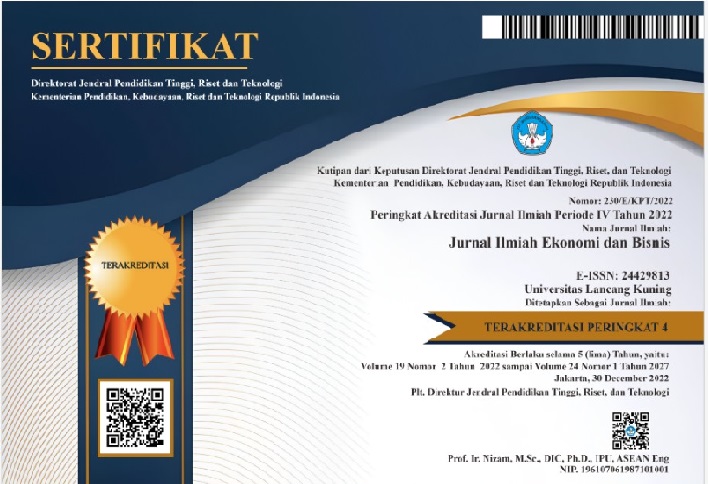INCOME AND EDUCATION INEQUALITY IN BANTEN
Abstract
Hampir dua dekade, persoalan ketimpangan pendidikan di Provinsi Banten belum teratasi secara maksimal. Penelitian ini mengkaji pengaruh faktor anggaran pendidikan, kemiskinan, ketimpangan pendapatan, dan ekonomi terhadap ketimpangan pendidikan. Pengukuran ketimpangan pendidikan digunakan dalam perumusan deviasi standar sekolah. Model analisis yang digunakan adalah regresi berganda. Data yang digunakan adalah data sekunder periode 2001 - 2019 yang bersumber dari BPS Banten. Hasil penelitian menunjukkan bahwa anggaran pendidikan dan ketimpangan berkontribusi dalam menurunkan ketimpangan pendidikan, sedangkan kemiskinan dan pertumbuhan ekonomi terbukti tidak mampu menurunkan ketimpangan pendidikan. Pemerintah harus mengurangi ketimpangan pendapatan dan kemiskinan dengan menyediakan akses peningkatan pendapatan, dan membangun infrastruktur sekolah ke desa-desa terpencil.
Downloads
References
Ahluwalia, M. S. (1976). Inequality , Poverty , and Development. Journal of Development Economics, 3, 307–342.
Anand, S., & Ravallion, M. (1993). Human Development in Poor Countries : On the Role of Private Incomes and Public Services. Journal of Economic Perspectives (Winter 1993), 7(1), 133–150.
Baldacci, E., Clements, B., Gupta, S., & Cui, Q. (2004). Social Spending, Human Capital, and Growth in Developing Countries: Implications for Achieving the Mdgs. IMF Working Papers, 04(217), 1–39. https://doi.org/10.5089/9781451875140.001
Birdsall, N., & Londoño, J. L. (1997). Asset Inequality Matters: An Assessment of the World Bank’s Approach to Poverty Reduction. The American Economic Review, 87(2), 32–37. Retrieved from http://www.jstor.org/stable/2950879 .
BPS. (2014). Situasi Pendidikan Provinsi Banten 2014. Banten: BPS Banten.
BPS. (2018a). Laporan Eksekutif Perekembangan Tingkat Kemiskinan Provinsi Banten. Banten. Retrieved from https://banten.bps.go.id/publication/download.html?nrbvfeve=NjU0YTY3ODk3MmZlNjM2NTBhZTliZDJk&xzmn=aHR0cHM6Ly9iYW50ZW4uYnBzLmdvLmlkL3B1YmxpY2F0aW9uLzIwMTkvMDMvMTUvNjU0YTY3ODk3MmZlNjM2NTBhZTliZDJkL2xhcG9yYW4tZWtzZWt1dGlmLXBlcmtlbWJhbmdhbi10aW5na2F0LWtlbWlza2luYW4tcHJvdmluc2ktYmFudGVuLXNlcHRlbWJlci0yMDE4Lmh0bWw%3D&twoadfnoarfeauf=MjAxOS0xMS0wNyAxNToxMjo0MQ%3D%3D
BPS. (2018b). Provinsi Banten Dalam Angka 2018. Banten: Badan Pusat Statistik.
Bustomi, M. J. (2012). Ketimpangan Pendidikan Antar Kabupaten/Kota dan Implikasinya di Provinsi Jawa Tengah. Economics Development Analysis Journal, 1(2), 1–10. Retrieved from http://journal.unnes.ac.id/sju/index.php/edaj
Checchi, D., & García-Peñalosa, C. (2004). Risk and the distribution of human capital. Economics Letters, 82(1), 53–61. https://doi.org/10.1016/S0165-1765(03)00224-6
Chowdhury, N. M., & Hossain, M. (2018). Poverty, Income Inequality and Growth in Bangladesh: Revisited Karl-Marx. https://doi.org/1812.09385v1
Datt, G., & Jolliffe, D. (1996). Determinats of poverty in Egypt: 1997 (FCND Discussion Papers No. 75). Washington, D.C.
del Granado, F. J. A., Fengler, W., Ragattz, A., & Yavuz, E. (2007). Investing in Indonesia ’ s Education : Allocation , Equity , and Efficiency of Public Expenditures (Policy Research Working Paper No. 4329). Washington, D.C.
Digdowiseiso, K. (2012). Education Inequality, Economic Growth, and Income Inequality: Evidence from Indonesia, 1996-2005. SSRN Electronic Journal, (17792), 1996–2005. https://doi.org/10.2139/ssrn.1602642
Doriza, S., Purwanto, D. A., & Maulida, E. (2013). Fiscal Decentralization and Disparity of Access to Primary Education in Indonesia Desentralisasi Fiskal dan Disparitas Akses Pendidikan Dasar di Indonesia Pendahuluan, 14, 223–233.
Ferreira, F. H. G., Chen, S., Dabalen, A., Dikhanov, Y., Hamadeh, N., Jolliffe, D., … Yoshida, N. (2016). A global count of the extreme poor in 2012: data issues, methodology and initial results. Journal of Economic Inequality, 14(2), 141–172. https://doi.org/10.1007/s10888-016-9326-6
Grimm, M. (2011). Does household income matter for children’s schooling? Evidence for rural Sub-Saharan Africa. Economics of Education Review, 30(4), 740–754. https://doi.org/10.1016/j.econedurev.2011.03.002
Harbison, R. W., & Hanushek, E. A. (1992). Educational performance of the poor: lesson from rural Northeast Brazil. Washington, D.C.: World Bank - Oxford University Press. Retrieved from http://documents.worldbank.org/curated/en/310981468770471105/pdf/multi-page.pdf
Inter-American Development Bank. (1999). Facing Up To Inequality in Latin America Economic and Social Progress. Washington, D.C.: Johns Hopkins University Press. Retrieved from https://publications.iadb.org/publications/english/document/Facing-Up-to-Inequality-in-Latin-America.pdf
Irkham, M. (2019). Analisis ketimpangan wilayah. Akuntabel, 16(1), 98–110.
Kemdikbud. (2017). Neraca Pendidikan Daerah Provinsi Banten 2017. Jakarta, Indonesia: Kemdikbud.
Kemdikbud. (2018). Neraca Pendidikan Daerah Provinsi Banten 2018. Jakarta, Indonesia: Kemdikbud.
Mankiw, N. G. (2015). Principles of Economics. (M. Worls, Ed.) (Seventh). Stamford: Cengage Learning.
Maozhong, L., & Shen Hua. (2011). Educational Inequality Analysis: International Comparison. International Journal of Business and Social Science, 2(16), 88–93. Retrieved from http://soe.sagepub.com/content/84/1/49.short
Mesa, E. P. (2007). Measuring Education Inequality in the Philippines. The Philippine Review of Economics, Vol. XLIV(No.2), 33–70.
Mok, T. Y., Gan, C., & Sanyal, A. (2007). The Determinants of Urban Household Poverty in Malaysia T.Y. Mok, C. Gan and A. Sanyal Commerce Division, P.O. Box 84, Lincoln University, Canterbury, New Zealand. Journal of Social Sciences, 3(4), 190–196.
Muttaqin, Z. (2018). Menjawab tantangan ketimpangan pembangunan di Banten melalui pembumian industri Banten bagi kesejahteraan masyarakat. Banten: Bappeda Provinsi Banten.
Nurdyana, H. S., Budiono, & Fahmi, M. (2012). Pendidikan Dan Kemiskinan Studi Kasus Provinsi Maluku Utara. Bandung: Universitas Padjadjaran. Retrieved from http://pustaka.unpad.ac.id/wp-content/uploads/2012/12/pustaka_unpad_pendidikan-_dan_kemiskinan.pdf
Park, W. G., & Brat, D. A. (1995). A Global Kuznets Curve? Kyklos, 48(1), 105–131. https://doi.org/10.1111/j.1467-6435.1995.tb02317.x
Pemerintah-DPR. (2003). Undang-Undang Nomor 20 Tahun 2003 tentang Sistem Pendidikan Nasional. Lemabaran Negara RI Nomor 4301. https://doi.org/10.16309/j.cnki.issn.1007-1776.2003.03.004
Pemerintah Republik Indonesia. (2008). Peraturan Pemerintah Nomor 47 Tahun 2008 tentang Wajob Belajar. Lembaran Negara Indonesia 4863.
Psacharopoulos, G., & Arriagada, A. M. (1986). The Educational Attainment of the Labor Force An International Comparison (Discussion Paper No. 38). Education and Training Series. Washington, D.C.
Psacharopoulos, G., & Arriagada, A. M. (1989). The determinants of early age human capital formation: evidence from Brazil. Economic Development & Cultural Change, 37(4), 683–708. https://doi.org/10.1086/451755
Psacharopoulos, G., & Patrinos, H. A. (2002). Returns to Investment in Education (POLICY RESEARCH WORKING PAPER No. 2881). Policy Research Working Paper. Washington, D.C.
Qian, X., & Smyth, R. (2008). Measuring Reginal inequality of education in China: widening coast-inland gap or widening rural-urban gap? Journal of International Development, 20, 132–144. https://doi.org/10.1002/jid
Rajkumar, A. S., & Swaroop, V. (2008). Public spending and outcomes: Does governance matter? Journal of Development Economics, 86(1), 96–111. https://doi.org/10.1016/j.jdeveco.2007.08.003
Ram, R. (1990). Educational Expansion and Schooling Inequality:International Evidence and Some Implications. Review of Economics & Statistics, 72(2), 266–274.
Rehme, G. (2007). Education, economic growth and measured income inequality. Economica, 74(295), 493–514. https://doi.org/10.1111/j.1468-0335.2006.00555.x
Roubini, N., & Sachs, J. D. (1989). Political and economic determinants of budget deficits in the industrial democracies. European Economic Review, 33(5), 903–933. https://doi.org/10.1016/0014-2921(89)90002-0
Schultz, T. W. (1961). Invetsment in human capital. The American Economic Review, 51(1), 1–17.
Sen, A. (1999). Development as freedom. Oxford: Oxford University Press.
Shapiro, D., & Tambashe, B. O. (2001). Gender, poverty, family structure, and investments in children’s education in Kinshasa, Congo. Economics of Education Review, 20(4), 359–375. https://doi.org/10.1016/S0272-7757(00)00059-5
Sinha, A., & Rastogi, S. K. (2015). Inequality in Access to Improved Water Source: A Regional Analysis by Theil Index. Theoretical Economics Letters, 5, 683–690. https://doi.org/10.4236/tel.2015.56079
Suryadarma, D. (2012). How corruption diminishes the effectiveness of public spending on education in Indonesia. Bulletin of Indonesian Economic Studies, 48(1), 85–100. https://doi.org/10.1080/00074918.2012.654485
Suryadarma, D., Suryahadi, A., & Sumarto, S. (2006). Causes of Low Secondary School Enrollment.
Sylwester, K. (2000). Income inequality, education expenditures, and growth. Journal of Development Economics, 63(2), 379–398. https://doi.org/10.1016/S0304-3878(00)00113-9
Syofya, H. (2018). Pengaruh tingkat kemiskinan dan pertumbuhan ekonomi terhadap indeks pembangunan manusia Indonesia. Jurnal Ilmiah Ekonomi Dan Bisnis, 15(2), 177–185. https://doi.org/https://doi.org/10.31849/jieb.v15i2.1153
Takahashi, K. (2011). Determinants of Indonesian rural secondary school enrolment: Gender, neighbourhood and school characteristics. Bulletin of Indonesian Economic Studies, 47(3), 395–413. https://doi.org/10.1080/00074918.2011.619053
Thomas, V., Wang, Y., & Fan, X. (2001). Measuring Education Inequality: Gini Coefficients of Education. Policy Research Working Paper, No. 2525. Washington, D.C.
Todaro, M. P., & Smith, S. C. (2015). Economic Development. (D. Battista & D. Alexander, Eds.) (Twelfth Ed). New Jersey: Perason.
Williamson, S. D. (2018). Macroeconomics. (N. Bhalla, M. Zeng, & A. Srivastava, Eds.) (Sixth). Harlow: Pearson Education Limited. Retrieved from www.pearsonglobaleditions.com
World Bank. (2018). Piecing Together the Poverty Puzzle. Piecing Together the Poverty Puzzle. Washington, D.C.: World Bank. https://doi.org/10.1596/978-1-4648-1330-6
Zhang, J., & Li, T. (2002). International inequality and convergence in educational attainment, 1960-1990. Review of Development Economics, 6(3), 383–392. Retrieved from http://www.blackwellpublishing.com/journal.asp?ref=1363-6669%5Cnhttp://search.ebscohost.com/login.aspx?direct=true&AuthType=cookie,ip,url,athens,uid&db=eoh&AN=0631788&site=ehost-live
Copyright (c) 2020 khusaini khusaini, hudaya hactuconsina, ambuy sabur

This work is licensed under a Creative Commons Attribution-ShareAlike 4.0 International License.










 This work is licensed under a Attribution 4.0 International (CC BY 4.0)
This work is licensed under a Attribution 4.0 International (CC BY 4.0) 